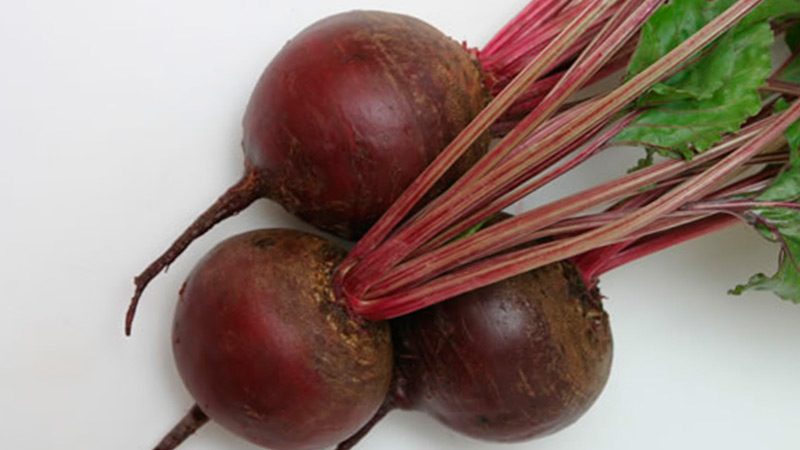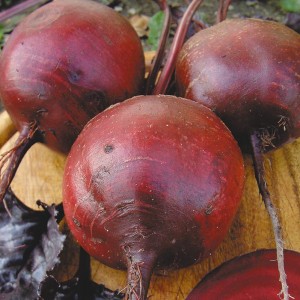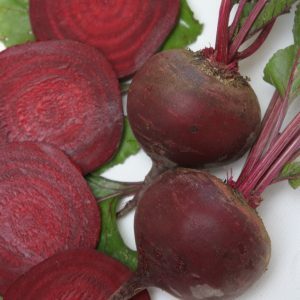Bordeaux beetroot: ideal color and flavor for cooking and long-term storage
Bordeaux beets are consistently popular with gardeners and culinary specialists. The former - for the ease of growing and care. In the latter, for the juicy, sweetish pulp and bright color, which remains unchanged even during heat treatment.
The content of the article
Description of the variety
Bordeaux beets are mid-season table varieties... It grows well throughout Russia, it is resistant to both high and low temperatures. She is unassuming in her care, and also beautiful stored in winter.
Bordeaux subspecies 237
Culture Bordeaux 237 (a kind of Bordeaux variety) was developed by Soviet scientists during the Great Patriotic War. In conditions of widespread hunger, a variety with a high yield was needed, and Bordeaux 237 is capable of producing crops twice a year.

Origin and development
The ancestor of Bordeaux was beet, which was brought to Russia at the beginning of the 20th century.
After carrying out breeding work two varieties were bred: Bordeaux single seeded and Bordeaux 237.
Distinctive features
The Bordeaux variety differs from others in its bright burgundy color, for which it got its name. Color is not lost during cooking. And the moderate size of the fruit allows you to bake them whole.
You can eat not only root vegetables, but also plant leaves (in salads, soups, marinades).
Attention! It is the Bordeaux variety that is resistant to diseases and is practically not affected by pests. It has almost one hundred percent germination and even tolerates a slight drought.
Fruit characteristics, yield
Root crops have a rounded shape, reach 10–15 cm in diameter, and weigh 350–500 g each. The rind is dense and dull.
Beet pulp is red-burgundy, juicy and dense, sweetish in taste. On the cut - uniform or slightly striped.
With proper cultivation and care, from 1 sq. m you can collect up to 8 kg of beets.
How to grow
Consider the features growing beets.
Planting with seeds / seedlings
In beets, in comparison with other vegetables, the seeds are quite large, they are planted in a prepared groove at a distance of up to 5 cm from each other.
Seeds can be sown both dry and pre-soaked in a solution with a growth stimulator.
For growing seedlings, seeds are sown in boxes in April. The result is that the crop ripens almost 20 days earlier than those planted directly in the ground. When 2-3 true sprouts appear leaves seedlings can be planted. This happens around mid-May, when the soil warms up to +10 ° C.
Variety Bordeaux 237 can be planted before winter: seeds are sown in the ground before the onset of cold weather and mulched. In this case, the harvest will be early. But for a long time such beets do not kept.
Care
In order for root crops to grow large and juicy, they need to water... Young beets are watered in the evening once a week, and in the morning the soil around the seedlings is loosened to avoid the formation of an earthen crust. Adult plants are watered less frequently.
To facilitate maintenance, many gardeners mulch the soil around their plantings. This avoids frequent loosening and watering.
Young shoots need regular weeding, otherwise the weeds will take away nutrients, and can also provoke various diseases.
Regular feeding is extremely important for the full development of root crops.At the beginning of the season, nitrogen is added for plant growth, and later for the formation of fruits - phosphorus, potassium, boron.
Reference! Beetroot gratefully responds to foliar feeding.
If the soil in your area is poor, then you need to fertilize it to replenish the nutrients. However, an overabundance of minerals can negatively affect the quality of root crops: they will crack, and voids form inside.
In addition, beets tend to accumulate nitrates, which are harmful to human health. When fertilizing with fertilizers, it is important not to exceed the dosage. Towards the end of the season, watering and feeding are stopped.
Features of cultivation and possible difficulties
Caring for beets is a simple matter. However, there are also secrets here.
- Beets love a sunny place.

- Do not plant root vegetables where cruciferous plants grew.
- The best predecessors in the garden are tomatoes, onions, garlic, eggplants.
- Beets like light, alkaline soils.
- Experienced gardeners make a beet border along the cabbage and carrot plantings. These vegetables have similar agricultural techniques, so it will be convenient to grow them nearby.
- Despite being hygrophilous, beets do not like stagnant water at the roots. With an excess, roots begin to rot. Therefore, you need to take care of good drainage.
- Beets need space to form full-fledged root crops. Therefore, do not plant plants close to each other.
Diseases and pests
Bordeaux variety is resistant to diseases and pests. But if, nevertheless, signs of phomosis, peronsporosis or powdery mildew appear on the plant, start processing immediately.
They love to feast on juicy beet leaves and various insects. In the fight against pests, folk remedies are effective: infusion of onion husks and wood ash.
Harvesting and application of the crop
Beets are harvested in autumn, before the onset of cold weather, when the leaves of the plant are already dying off.
Carefully, so as not to damage the integrity of the beetroot skins, dig the root crop out of the soil, peel off the soil and tear off the tops. Then you need to cut off all the growth points so that during long-term storage the beets do not start sprouting.
Next, we sort the roots. Damaged and deformed ones are recycled. Healthy, but not too large (large tubers are poorly stored) are set aside for long-term storage for the winter.
Advantages and disadvantages of the variety

Reduced Bordeaux is universally loved by gardeners. It is famous for its stable yields, resistance to heat and drought, and is well stored until spring.
Bright, neat root vegetables are distinguished by their juiciness and sweetish taste. The fruits are not too large, so it is convenient to bake them and use them in salads.
Bordeaux has practically no drawbacks.
Varieties of varieties
The Bordeaux variety has two varieties: Bordeaux 237 and Bordeaux single-seeded. The only difference between them is that after germination, one-seeded beets do not need to be thinned out, since only one sprout germinates from each seed.
Bordeaux 237, in turn, became the progenitor of the Incomparable A-463 and Podzimney A-474.
The incomparable one has a delicate taste and quick ripening (70 days).
Podwinny can be sown in late autumn for an early harvest. And it is also resistant to color.
Farmers reviews
We bring to your attention the reviews of summer residents who have already cultivated the Bordeaux variety and its varieties.
Olga, 57 years old, Rostov region: "Our family loves beets. We plant a lot, tried different varieties. But Bordeaux is beyond competition. Always a big and tasty harvest. We even tear the tops into salad and cold borscht. "
Alexey Ivanovich, Chelyabinsk: “I plant Bordeaux beets every year. She is very tasty. And it keeps well. Of course, I weed, I water. But I didn’t notice that it grew worse in dry summer. We always collect a lot. I tried to grow and prepare the seeds myself - it didn't work. A lot of trouble. It is easier to buy ready-made ones, there are many of them now and are inexpensive.
Alexander, Moscow region: “We have been planting beets in the country for several years already. And recently we stopped at Bordeaux.There is practically no leaving, the main thing is to water on time. But borscht from your beets is delicious! Both bright and tasty. And we also love to gnaw raw beets: cut into slices and crunch. "
Conclusion
Bordeaux beets are an excellent choice for gardeners and culinary specialists. This is a time-tested, resistant variety. And beautiful, and tasty, and healthy, and easy to care for, the culture stands out against the background of other varieties. Good luck in growing and cooking!